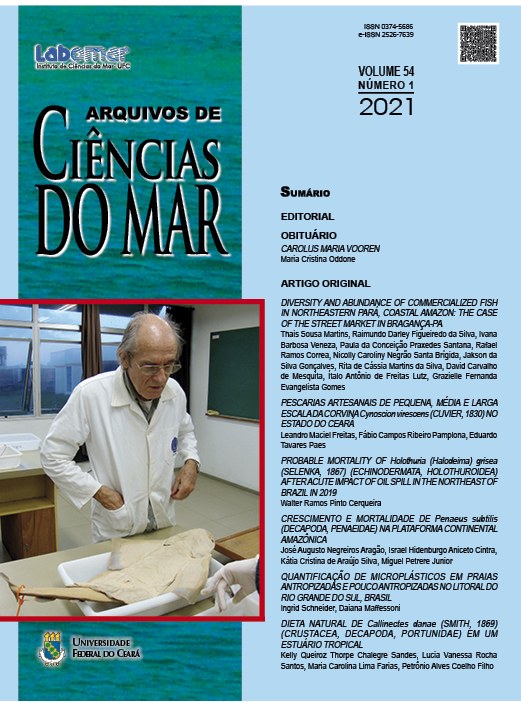Natural diet of Callinectes danae (Smith, 1869) (Crustacea, Decapoda, Portunidae) in a tropical estuary
DOI:
https://doi.org/10.32360/acmar.v54i1.44100Abstract
This research characterized the natural diet of Callinectes danae in the Estuarine System of the Canal de Santa Cruz (Northeast Brazil), through the analysis of stomach contents considering its seasonal variation, by sex and ontogenetic development. The samplings occurred in the dry period (February/2004) and in the rainy period (June/2004), with the use of wing trawl (5 mm mesh), with duplicate, for 15 minutes. The diet was analyzed qualitatively and quantitatively, based on the occurrence and frequency of relative points. A total of 508 stomachs were analyzed, of which 312 were captured in the dry season and 196 in the rainy season. In the dry period, male and female samples presented 75% of the stomachs with food and 25% empty. In the rainy period, 51.16% of males had stomachs with food and 48.84% empty; while in females, 51.82% had food and 48.18% empty. The trophic spectrum was composed by 10 elements, being the items Mollusca, AOM and
Crustacea the most frequent in both periods. There was no significant difference, however adult individuals had more diversified diet, with a preference for Mollusca, unlike young individuals, where AOM was the preferred item, although this item can be represented by many groups.
Keywords: swimming crab, stomach contents, feeding, food ecology, Canal de Santa Cruz.
Downloads
Published
Issue
Section
License
1. Proposta de Política para Periódicos de Acesso Livre
Autores que publicam nesta revista concordam com os seguintes termos:
- Autores mantém os direitos autorais e concedem à revista o direito de primeira publicação, com o trabalho simultaneamente licenciado sob a Licença Creative Commons Attribution que permite o compartilhamento do trabalho com reconhecimento da autoria e publicação inicial nesta revista.
- Autores têm autorização para assumir contratos adicionais separadamente, para distribuição não-exclusiva da versão do trabalho publicada nesta revista (ex.: publicar em repositório institucional ou como capítulo de livro), com reconhecimento de autoria e publicação inicial nesta revista.
- Autores têm permissão e são estimulados a publicar e distribuir seu trabalho online (ex.: em repositórios institucionais ou na sua página pessoal) a qualquer ponto antes ou durante o processo editorial, já que isso pode gerar alterações produtivas, bem como aumentar o impacto e a citação do trabalho publicado (Veja O Efeito do Acesso Livre).

